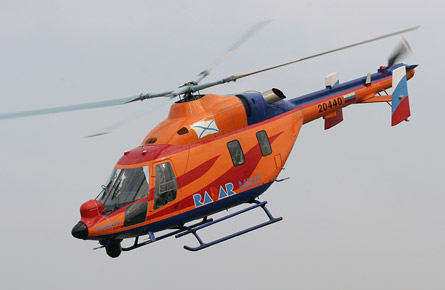Russian Helicopters may be poised to resolve long-running certification problems with its Ansat multipurpose light twin.
The company plans to introduce a new variant featuring a traditional hydraulic-mechanical control system, to replace the fly-by-wire system that has featured on the type since the aircraft first flew a decade ago.
Two prototypes of the hydraulic-mechanical version have been built by Russian Helicopters' Kazan Helicopters plant, one of which recently made a first demonstration flight.
According to Kazan Helicopters general manager Vadim Ligay, certification in Russia should be completed by the end of the year, and "after that we are not afraid to undergo certification to Western standards."
Ironically, the Pratt & Whitney PW207K-powered Ansat, with a m
aximum take-off weight of 3,600kg and a nine-passenger capacity, has been dogged by one of its most advanced features - the fly-by-wire control system.
Ligay underscores Russian Helicopters' absolute confidence in the reliability of the system - the fatal crash of an Ansat operated by South Korea's forestry service in July 2008 was determined to have been caused by "external factors" - but he says that in the absence of any civil certification standard for fly-by-wire helicopters it was decided to develop a version with a traditional control system.
 |
|---|
© Russian Helicopters Two prototypes of the hydraulic-mechanical version have been built by Russian Helicopters |
Ligay says the hydraulic-mechanical control version should also be more attractive to the company's traditional customers in the CIS, Southeast Asia, Africa and Latin America.
In the best Mil tradition, the machine is designed to be simple and robust - "Ansat" means "easy" in the local Tatar language - and to operate day or night in extreme weather and a variety of configurations. Pratt & Whitney power could be supplanted by a currently-experimental Klimov engine, the VK-8, to power a heavier version with 4.5t take-off weight.
Ligay says a go-or-no decision on the heavy variant will be made by Russian Helicopters.
Meanwhile, sales are clearly an issue. At present the only customer in the orderbook is the Russian military, which has ordered an undisclosed number - thought to be about 30 - of a training variant of the standard fly-by-wire machine, the Ansat-U.
At the time of the 2008 accident Kazan had delivered five Ansats to Korea - four to the forestry service and one to the police - and had orders for one helicopter from Laos and one in medevac trim from Tatarstan, of which the city of Kazan is the capital.
Another Ansat has been delivered domestically to test missile guidance systems.
Source: Flight International























